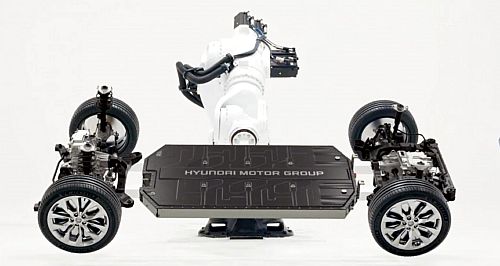Make / Model Search
News - HyundaiHyundai’s solid-state battery uses copperPotential game changing battery tech for EVs from Hyundai21 Aug 2025 REVEALED via US Patent Office filings is news that Hyundai may be onto game changing battery tech’ using copper in solid state batteries.
Solid-state batteries are a type of lithium-ion battery that replace the liquid or gel electrolyte with a solid material offering several potential advantages over traditional lithium-ion batteries including increased energy density, lower cost, improved safety with a lower risk of thermal runaway and faster charging times.
Because they have the potential to store more energy in the same volume or weight, theoretically solid-state batteries may lead to longer ranges for electric vehicles.
The technology is still in development phase by various companies and is viewed as “promising” particularly for the future of electric vehicles and other applications.
Given the various stages of development the earliest likely mass production of solid state batteries for use in EVs is a few years away perhaps 2027.
Reported in publication Electrive, Hyundai’s patent application describes a method enabling copper to function inside the cells of sulphide-based solid-state batteries. The technology is designed to improve conductivity, durability, and cost efficiency compared to existing designs.
Until now, copper has been avoided in this environment because sulphides are corrosive, forcing manufacturers to rely on nickel or stainless steel says Electrive.
“The patent outlines the use of a protective coating (buffer) applied over a copper anode current collector that “could deliver significantly better adhesion, letting it stick together longer and have more durability”.
The process may also maintain capacity over more charge/discharge cycles as the layered design comprising copper collector, protective coating, anode, sulphide electrolyte, cathode, and terminal collector, allows copper to withstand the electrolyte without degrading.
Electrive says by reintroducing copper, the battery cell could benefit from its high conductivity and lower cost, while improving stability and internal performance in demanding EV applications.
Delving deeper into the technology Electrive says “The buffer is formed from a carbon sheet with oriented carbon materials, potentially vertically aligned carbon nanotubes, combined with lithiophilic metal particles such as silver, gold, or aluminium”.
As the patent specifies, the buffer layer “may have a porous structure” and maintain stability even when fully charged, helping to suppress lithium deposition at the edges of the anode and ensuring more uniform cycling.
Conventional lithium-ion batteries already rely on copper current collectors to transfer electrons effectively. Solid-state batteries had to rely on more expensive and less conductive materials. This limitation has long posed a cost and performance barrier for the latter.
The publication speculated that if successful, the new technology could enable copper’s return as a cost-effective, high-conductivity material for solid-state cells, replacing stainless steel or nickel alloys currently required to resist corrosion.
This would not only lower material costs but also enhance efficiency within the cell.
Solid-state batteries are widely viewed as a next-generation energy storage solution for EVs.
A number of manufacturers including Toyota and BYD are currently working on the technology, though according to Electrive commercialisation timelines vary.
BYD is reportedly testing a solid-state battery with a 1500km range and 12-minute charging time.  Read more4th of August 2025  Hyundai lands local Xcient remanufacturerHyundai backs Advanced Manufacturing Queensland for hydrogen truck remanufacture24th of July 2025  Hyundai shakes up its Kona SUV line-upTurbo-petrol Kona axed as new Elite grades join Hyundai’s small SUV range14th of July 2025  Hyundai unleashes Ioniq 6 N at Goodwood FOSKorean marque adds to its high-performance EV line-up, introducing 478kW Ioniq 6 N |
Click to shareHyundai articlesResearch Hyundai Motor industry news |











Facebook Twitter Instagram